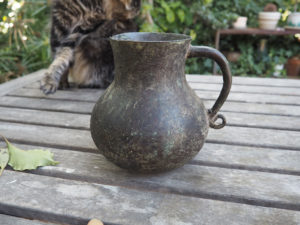 LY sent me a simple bronze drinking vessel, a tulip shaped beaker with a rat tail handle, attached at the most bulbous area with a curl flourish. Because LY’s tabby cat is also in the photo, I can tell the beaker stands 4-5” tall. That outward curl flourish, located where a pinky finger might grip the handle, is an old tradition.
LY sent me a simple bronze drinking vessel, a tulip shaped beaker with a rat tail handle, attached at the most bulbous area with a curl flourish. Because LY’s tabby cat is also in the photo, I can tell the beaker stands 4-5” tall. That outward curl flourish, located where a pinky finger might grip the handle, is an old tradition.
How old is this bronze drinking vessel? First, we investigate the shape. How difficult is the shape to cast in bronze? Pretty difficult. Easier to form a straight flare-sided cup in bronze. But the tulip beaker is easy to throw in clay. Because clay was humankind’s first medium it became a protype for many later forms. Many cultures through the millennia translated clay forms into bronze. In fact, terminology to track the progression of the Ages uses dominant materials: Stone, Copper, Bronze, Iron.
We find LY’s bronze drinking vessel’s shape in clay where cultures grew grape vines.
We see tulip beaker shapes in Iran, Georgia, and on the Iberian Peninsula, early wine growing regions. We find the shape with or without handles, in clay, in areas of viticulture. I assume the shape lends itself to the smell of fermented liquid or wine. Or because liquid finds it harder to flow from an indented waist, they used the vessel for precious liquids—wine! I found great photos examples on the Wine History Foundation’s website. Of special interest I noticed the many clay vessels and a few bronze tulip beakers at their earliest date of fourth though third millennia BC. Explorers discovered them from the Caucasus to the Middle East.
That does NOT mean LY’s beaker is that old, it means the form is that old. Why work a difficult form in bronze? Let’s look again at cultures that grow wine. Those cultures associated wine with a deity. Craftsmen worked objects that held wine in more precious metals and worked with relief decorations, sometimes mythological. So wine vessels became special. They used a harder to work, rarer material when a vessel is reserved for special liquids or occasions. Even today in our shut-down world, we consider wine special. Oh, so special! I break out a fine crystal wine glass some evenings.
Emergence of the Tulip Beaker Form
Because of the level of craftsmanship to make, one archeologist wrote that the emergence of the tulip beaker form coincides with the development of Urban Culture. As urban culture differentiated itself from agrarian, we see the form moving from execution in clay to bronze. Such clay examples carbon date from the Iberian Peninsula from the fifth through fourth millennia. Again, I mean the emergence of the form, not YOUR beaker. But we first examination the history of the form when we have no comparable object in our data base.
How old is LY’s beaker?
If in clay, the form might indicate a Neolithic origin. If bronze, we’d hear about a Bronze Age origin and a date perhaps of 3000 BC. Now here’s the kicker: this form has never fallen ‘out of production.’ I found examples in bronze from the 18th century, although they exhibited less primitive lines. This form never left cultures that fermented and drank the results! I found a 1750 to 1780, American or British tulip form copper mug. Formed out of sheet copper, this mug has a hollow foot. Its hollow handle also hammered out of sheet copper, and its curved bottom end adorned with a large heart-shaped finial. This tankard shows silver plating inside the body, a necessity to protect the contents from contact with the copper, which sours the liquid.
LY believes the beaker is pre-Renaissance, before the 15th century. Could it be late medieval? Yes, and if late medieval, let us go back to an area in which this form originated, the Iberian Peninsula. If this beaker came from medieval Spain, we know Islam rose after AD 632. The Kingdom of the Visigoths reigned at that time. So, LY, you might own a Gothic Bronze tulip Beaker. If so, I couldn’t put a value on such a rare piece. An 18th century beaker sold for $500.